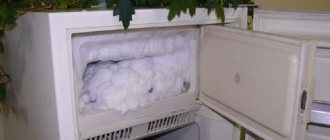In recent years, refrigerators equipped with the No Frost system have become very popular. Advertising played a significant role in this, claiming that such units do not require regular manual defrosting. However, this statement is only partly true, since in order to carry out general cleaning in the chambers, periodic defrosting of the No Frost refrigerator will be required. In addition, the refrigerator must be defrosted during routine inspections, while the ventilation system is being cleaned, to troubleshoot problems.
Automatic defrosting of the No Frost refrigerator
Frost-free operation (as the name of the technology is translated) is ensured by air circulating through the chambers, supplied by a built-in fan. The evaporator is removed from the chamber to the rear wall of the unit. The air flow, passing through the evaporator, cools and passes into the chambers.
Having given off heat, it returns along with water vapor to the evaporator, on the cold surface of which moisture settles in the form of condensate, which forms frost when it freezes. 2 – 3 times a day, during compressor stops, the ice is melted by an electric heater and removed outside. The appearance of ice on the walls is possible when the door is opened frequently, if it remains open for a long time, or due to a defect in the seal.
On Japanese and South Korean models (Samsung, LG), such a defrosting system is installed in both chambers. This is due to the high air humidity in these countries due to their proximity to the sea, and the No Frost refrigerator copes well with this problem. European manufacturers produce similar models (for example, from Stinol), but there are also combined models in which the freezer is equipped with No Frost, and the refrigerator compartment is equipped with a drip system.
Defrost types
There are several ways to get rid of ice on the walls of the refrigerator. Each of them has its own characteristic features.
Manual
Without human intervention, the ice will not melt on its own. You need to wait until the thawed water collects in a special tray. The event involves the following actions:
- it is necessary to disconnect the unit from the network;
- free all space from shelves and products;
- open the door;
- then all surfaces should be washed;
- wipe all walls dry;
- Reconnect the unit to the power supply.
Bosch is considered a popular and reliable company. For the refrigerator compartment, only automatic drip or “No Frost” defrosting mode is used. The freezer defrosting system in Bosch refrigerators can be manual or automatic.
Semi-automatic
Models of household appliances with semi-automatic defrosting mode require human intervention:
- To start the ice defrosting process, you need to press the special defrosting mode button.
- Then the frost slowly melts.
- As soon as the ice has completely melted, operation of the refrigerator resumes automatically.
Automatic
Automatic defrosting saves time and effort. A thin layer of ice forms on the walls of the refrigerator and begins to evaporate in the form of condensation.
Water passes down the back wall through special channels and collects in a tray. Many models with an automatic defrosting system are produced by LG.
Operating principle of drip defrosting
In refrigerators with drip defrost, the evaporator is located on the back side of the back wall of the chamber. Therefore, it is colder than other surfaces and, in accordance with the laws of physics, moisture contained in the air condenses on it. During operation of the compressor, it forms ice, which, after stopping, begins to melt and flows drop by drop into the outer container. Simplicity and the absence of additional devices make this system very reliable. The main disadvantage is the inability to work in the freezer.
Advantages and disadvantages of No Frost
The advantages of the system include:
- When used correctly, refrigerators with this technology ensure frost-free operation, so you need to defrost a No Frost refrigerator much less frequently than similar models with manual or drip defrosting.
- Due to the uniform temperature distribution inside the chamber, high quality freezing is ensured on all shelves.
- Another advantage is the ability to quickly restore the set temperature after loading a large number of products into the chamber. The packaging of the products does not freeze together.
- To ensure that greens and berries remain fresh for a long time, most refrigerators of this type have special compartments for storing them, where the temperature is maintained at 0C.
The disadvantages include:
- Dehydration of stored foods, but if you store them in airtight containers or wrap them in film, this will not happen.
- Since space is allocated for the system, No Frost refrigerators have 20% less chamber volume than similar models of other types.
- When the fan and compressor operate simultaneously, the noise level is high. However, manufacturers claim that the latest models operate virtually silently.
- Additional electricity is consumed to operate the fan.
- The cost is higher than that of drip analogues. But if you choose models from a line of the same level, the difference will not exceed 7–12%.
- Installed fans and automation that are prone to breakdowns reduce reliability. However, even if the system fails, the unit, even if not at full capacity, will continue to work, waiting for the breakdown to be repaired.
Pros and cons of No Frost
Wind freezing is considered more modern and progressive; it has a number of noticeable advantages. However, it is not without its drawbacks.
| Advantages | Flaws |
|
|
Attention! The problem of drying out food is easily solved: just store it in the packaging. Moreover, today kitchen units have a compartment for vegetables and fruits.
How to properly defrost a refrigerator with No Frost
The debate about how often you need to defrost the refrigerator still continues, but both sides agree that this procedure should be carried out at least once a year to do general cleaning. The most important thing is that you should not turn on the refrigerator immediately after cleaning and cleaning!
If at least a couple of hours do not pass after the shutdown, the compressor motor will be overloaded upon startup and will fail!
- Defrosting should be carried out in a cool environment so as not to damage the unit due to a sudden temperature change. If circumstances force you to defrost in hot weather, it is better to postpone the procedure to the evening or night hours.
- How long you need to keep the refrigerator turned off will depend on the circumstances. A day is considered optimal, but if necessary, 12 hours is enough. This is required to reduce the pressure in the refrigerant circulation system.
- Refrigerators with separate cooling systems have the ability to turn off the chambers. Therefore, they can be processed sequentially, first, for example, the disconnected refrigerator compartment, then the freezer. In models with one cooling circuit, it is impossible to do without defrosting both compartments at the same time.
Refrigerator with no frost function ATLANT XM 4524-060 ND.
Defrosting a refrigerator with a no frost system is carried out in the following sequence :
- After disconnecting from the power supply, food supplies are unloaded from the refrigerator.
- Removable elements, shelves, containers are removed. They are washed from dirt and dust with liquid detergent and set to dry.
- If there is a coating of frost on the walls, you cannot scrape it off with sharp objects so as not to damage the surface. It's better to let it thaw. To speed up the process, defrost using a hair dryer. Then, using a dry cloth, remove debris from the chamber and blot off the condensation.
- Surfaces are washed with soapy water, moistening a sponge or rag in it. To get rid of unpleasant odors, use a soda solution. To remove mold and mildew from the door seal, use lemon juice or ammonia. To wash the inside of the refrigerator and removable elements, do not use aggressive detergents, as their particles can get on the food, and the use of abrasive brushes and powders will damage the coating
- The ventilation holes of the system are cleaned with cotton swabs soaked in a soda solution. It is prepared at the rate of 2-3 tbsp. l. powder per 0.5 liters of water. You should not install ventilation grilles, as this will entail refusal of warranty repairs, regardless of the type of malfunction.
- Now you need to go over the surfaces with a sponge soaked in clean water and wipe them with a clean cloth.
- To complete general cleaning, the unit is moved away from the wall and the rear is cleared of accumulated dust deposits. And housewives don’t need to be taught how to clean the outside of a refrigerator.
- The doors open and the unit is left alone for the time specified above.
- At the end of the period, the containers and shelves are put in place, the doors are closed and the clean refrigerator is put into operation. After half an hour, the loading of products in full begins.
How often should you defrost your refrigerator?
It all depends on its age and cooling technology. Now all refrigerators are equipped with either a drip system or a No Frost system. They do not require frequent cleaning to remove ice build-up. But older models can be much more capricious.
Without auto defrost
It all depends on a bunch of factors: manufacturer, technical data, model, frequency of opening and closing the door... Even the season has an effect. Devices without auto-defrost are a real rarity. As a rule, these are very old units that are being forced out of the market by more convenient models. How often does it need to be defrosted? It is best to look at the device's data sheet. Manufacturers provide this information.
What if you don’t have a passport? Then follow simple rules:
- Don't expect complete glaciation. The critical figure is 2 mm. If the ice is thicker than two millimeters, the load on the compressor will increase, and it may simply fail. And where will you find a replacement for a rarity?
- In summer, the ice will melt faster than in winter, so you need to defrost it once a month (more often if the “fur coat” quickly increases in size).
- In winter there is less ice, the intensity of defrosting can be reduced to once every 3-4 months.
With auto defrost
There are three types of cooling systems with auto-defrost: drip, No Frost and mixed. What are the features? During drip defrosting, all the condensate thaws (thanks to the evaporator) and flows through special grooves into the pan, from where it safely evaporates. True, the drip system is only available for the refrigerator compartment. The “fur coat” will still grow on the freezer and will need to be defrosted. In the case of No Frost, condensation has no chance of forming: such devices are cooled by fans, which, among other things, “dry” the air. Excess moisture will simply dry out. The system works in both the refrigerator and freezer compartments. Mixed type: drip system in the refrigerator, No Frost in the freezer.
How often should I defrost?
- Refrigerators with a drip system - approximately once every 6 months, mainly to get rid of bacteria and “fur” in the freezer.
- Devices with know frost, in principle, do not require defrosting. But some manufacturers still recommend giving the unit a “rest” once a year. Well, again, you need to get rid of bacteria, otherwise the food will spoil faster.
- Mixed type units are also washed once a year.
If in doubt, refer to the technical documentation. The manufacturer provides recommendations on this topic.
Recommendations for using the system
To avoid having to deal with unscheduled defrosting, get into the habit of following simple rules:
- Clean up debris and spilled liquids immediately upon occurrence;
- Do not place food into the chamber that has not cooled down to room temperature. In principle, No Frost will cool them down, but you should not test the refrigerator's endurance.
- Products must be stored in airtight packaging.
- Do not load food into the chambers that does not require refrigeration.
When following the debate about whether it is necessary to defrost a No Frost refrigerator, it is worth listening to the opinion of the side advocating systematic care. Still, a clean, pleasant-smelling unit looks better than a smelly, dirty box. When you look at it, the question arises: can it be used to store food without harm to health?
Refrigerator Stinol RF 345 A
Refrigerator Stinol RF 345 A 008 is a brand of refrigerator where the refrigerating chamber is equipped with a “drip” evaporator, here defrosting occurs automatically. When the compressor turns off, the frost on the surface of the evaporator melts. And then it flows in drops through the drain hole into the condensate tray. There is no No Frost system in this refrigerator. The freezer compartment is defrosted manually. The refrigerator compartment can be cleaned and washed once a year, as it gets dirty.
The video shows all the details of defrosting and washing the refrigerator:
General defrosting and cleaning of the refrigerator.











